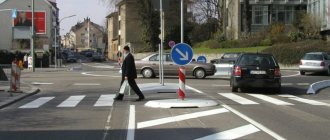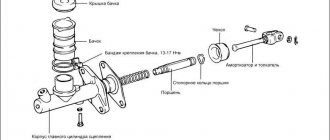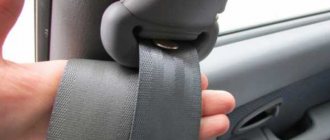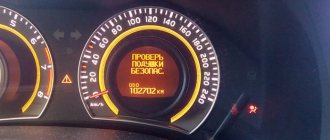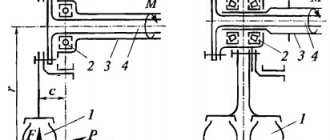Hello dear motorists! Each of you held in your hands a book with the rules of movement, you also understand perfectly well what it represents. This is a small booklet consisting of 30 pages, a good half of which are images of traffic lights, traffic controller gestures and road signs. That is, the text of the traffic rules itself consists of about 15 pages of small text, which, like any legislative act, are very difficult to perceive and require explanations, examples and comments. Today we will examine in detail such a term as a safety island.
Stopping and parking
Let us return to the clarification that the concept “What is not prohibited is permitted” cannot be applied to the Traffic Rules. This is reflected in the requirements for stopping and parking.
Read also: Why shouldn't pregnant women kick cats?
12.1. Stopping and parking of vehicles is permitted on the right side of the road on the side of the road, and in its absence - on the roadway at its edge and in the cases established by paragraph 12.2 of the Rules - on the sidewalk.
On the left side of the road, stopping and parking are permitted in populated areas on roads with one lane for each direction without tram tracks in the middle and on one-way roads (trucks with a permissible maximum weight of more than 3.5 tons are allowed on the left side of one-way roads only stopping for loading or unloading).
12.2. It is allowed to park the vehicle in one row parallel to the edge of the roadway. Two-wheeled vehicles without a side trailer may be parked in two rows.
Penalty for driving on this section of the roadway
A common unscientific argument against traffic islands is that drivers can run over them, causing the traffic island itself to cause accidents by reducing safety in the area. Indeed, an improperly designed and equipped island can cause accidents.
correct design and implementation - for example, the island should have rounded edges, signs on it should not block the visibility of pedestrians and drivers; proper lighting - the island at the crossing should be visible to drivers, as well as pedestrians at the crossing; keeping signs clean, maintaining their visibility and reflective properties.
Distance from intersections and crossings for stopping
At least 5 meters must remain from the vehicle to:
- crossroads,
- pedestrian crossing.
After crossing roads, you also need to maintain a distance of at least five meters.
See also: Is life insurance required with compulsory insurance or is it possible without it? Attention! Exceptions are intersections that resemble a “T” shape. Cars can stop directly opposite the intersection if there is a shoulder or the distance from the car to the solid marking line is at least three meters. This is the only case of parking at an intersection according to traffic regulations.
You can stop immediately after a zebra crossing if there are no prohibiting signs. In this case, the vehicle will not block the view of the flow of cars traveling in this direction.
As for parking at turns, uphills and downhills, you can leave your car only where the visibility of this area is at least 100 meters. You cannot park your car in front of dangerous turns. As for other cases, it is advisable to stop before going up the hill, rather than going down (since visibility is better).
In any case, leaving the car on a surface from which it can roll forward or backward, you should turn the wheels so that when moving the vehicle moves further to the side of the road.
Horizontal marking
This includes everything that is “drawn” on the asphalt. Such lines indicate the order of movement along this section of the roadway. Horizontal markings on the road are useful not only for car owners, but also for pedestrians.
To decipher the meaning of the lines, use the following table:
There are certain types of horizontal markings that are not used in all cities. Eg:
See also: Assistant Arbitration Manager and its automated version
- 24.7 – looks like a rectangle and the letter D. Allows parking only for diplomatic vehicles.
- 24.3 – designates parking spaces allocated for disabled people of any group.
- 24.5 – only electric vehicles may park or move in this location.
All other types of markings only duplicate road signs.
Controversial situations when crossing road markings
- Is it possible for a car to stop on a traffic island? No! Stopping in this place is prohibited, since this marking is designed for pedestrians who did not have time to leave the road section at the traffic light, which gave the right of way to the car. As you know, vehicles are prohibited from stopping at zebra crossings.
- Is it possible to run over and stop at a junction of traffic flow? No! If the island is located at a junction or branch of traffic flows, which can be considered an intersection. Accordingly, stopping at the intersection is prohibited by traffic regulations.
- Is it possible to stop on an island if it is located at a junction of traffic flows that are not at intersections? Yes! Traffic regulations do not prohibit stopping on a guide island. Consequently, the inspector does not have the right to punish the driver for violating the rules of stopping or parking. But, for violating the intersection of road markings, maybe! After all, crossing a solid line is prohibited.
- Is it possible to park a car on this section of the road? As for parking, you need to look at which island it is. The corresponding markings can be applied to the asphalt in the middle of the street, at a pedestrian crossing, at an intersection, as well as in places where traffic flows merge or separate on a multi-layer road. If the driver decides to park his car on this island, which is intended specifically for pedestrians, he will essentially be in the center of the pedestrian crossing.
- Responsibility for hitting a car with a wheel when overtaking. When overtaking another vehicle, one wheel is allowed to collide with the traffic island area.
Concept
Every road user is required to know, according to traffic regulations, that a traffic island is a section that is intended for pedestrians. In addition, it separates traffic flows in which cars move in opposite directions.
Safety islands are applied as markings on roads. If for some reason a pedestrian did not have time to cross the roadway, he can calmly wait in this area for a favorable situation for an unhindered crossing.
In Russia, safety islands are not so common. The situation is different in European countries. There are so many similar markings there that drivers inevitably begin to behave more disciplined and follow traffic rules.
Marking: what areas to apply to?
Thanks to markings, safety islands can most often be seen on:
Read also: How to view the blacklist of Sberbank
- Pedestrian crossings. Moreover, they can be either regulated or unregulated.
- Crossroads. Mostly markings are applied at intersections of roadways where roundabout traffic is organized.
- Entrances to populated areas.
Properly applied markings increase the vigilance of drivers, forces them to reduce speed, prevents them from entering the oncoming lane (for example, in order to overtake), eliminates parking at a pedestrian crossing and in the immediate vicinity of this area, and ensures the safety of passers-by.
Sometimes zebra crossings are applied to areas where vehicles move very quickly. As a rule, we are talking about a wide roadway, the parameters of which are greater than the established standards. In this case, it is advisable to transform the extra zones into islands. Marking in this case will significantly reduce the likelihood of an accident.
What the traffic rules say about traffic islands
Marking 1.16.1 is a small island with lines written on it. They can be seen on sections of highways and city roads. They are often applied when the roadway narrows. If we talk directly about the traffic island, they are applied exclusively at pedestrian crossings, namely in the middle of it. This point is indicated in the definitions of traffic rules with number 2.42.
The island is designed for safe pedestrian crossing of the road. The presence of such an island is especially important on roads with 4 or more lanes. However, in many European countries they can be seen even on two-lane roads. In this case, they are designed to calm traffic; the driver does not have the opportunity to accelerate to high speeds on a narrow road. They are equipped with special lighting and sometimes a road sign. This reduces the accident rate and all related indicators, such as accident rates and the number of pedestrians hit.
Such markings indicate to the pedestrian where he can safely wait for the flow of cars or wait for the green traffic light. Safety islands are very convenient for older people and people with limited mobility who find it difficult to cross a road, especially one with 6 lanes at a time. With a traffic island, this can be done with some pause, while remaining in a safe place and without interfering with moving traffic.
Foot columns
The movement of organized pedestrian columns in the traffic rules with comments is described as follows: people can walk along the road only in the direction of the movement of cars, i.e. on the right and up to 4 people in one row. One escort with a red flag is placed in front and behind the column. These people should be on the left side of the line. At night and in case of insufficient visibility, movement is carried out using a white light in front, red in the back. Groups of children can be driven along sidewalks and pedestrian paths, or, if they are not available, along roadsides, and there must be an accompanying adult.
Remember
- A safety island is made by markings or by raising it above the road.
- The island is needed to separate traffic flows and protect pedestrians on the wide road.
- The fine for crossing or turning around on an island is 500 rubles.
- The fine for stopping or parking on an island is 1,000 rubles.
- If the fine is not paid within 70 days, the fine will be handed over to the bailiffs, who will write off the amount of the fine from the account.
- To receive notifications about fines on time and pay fines at a discount, subscribe to notifications on the Traffic Police Fines website.
How to receive notifications on time to pay a fine at a discount
It happens that due to a large influx of visitors, electronic services work with malfunctions or a long delay. This was the case when the president signed a decree on child benefits in June 2022. Parents began to process payments through government resources and overloaded the server. There was no access to other services, such as checking fines, for a long time.
In order not to depend on force majeure, subscribe to the traffic police fines notifications. The service takes information directly from the GIS GMP database. All duties, fines and taxes in favor of the state pass through it.
How to avoid problems?
If you need to regularly use a tow bar, then it makes sense to install a removable or sliding version. In this case, you will install it only for transporting the trailer; the rest of the time the trailer will either be removed or located under the bumper. If the tow bar does not extend beyond the body, then there will be no formal grounds for complaints.
Another way is to register changes with the traffic police
. Here you should take into account that you will only need to use a towbar approved by the manufacturer; no homemade products can be used here. Here are the steps you will have to go through:
- Installation work is carried out only by an authorized service that has permission to perform such actions. Don't forget to take a certificate;
- State duty is paid;
- Fill out an application to the traffic police, be sure to attach a copy of the vehicle title and documents for the towbar. All documents are submitted to the MREO.
All that remains is to wait for permission to be received, which usually takes one day. conclusions
. Quite often, drivers have to transport various trailers. But here the question arises: is it possible to drive with a towbar without a trailer? The answer largely depends on the technical features of your car. In general, installing such a device yourself can lead to unpleasant consequences in the form of fines.
Functions
First of all, traffic islands are designed to divide the road into two parts. In addition, they are areas where pedestrians can remain for any length of time. People crossing the roadway do not need to control the traffic flow from all sides.
In areas where there are no appropriate markings, accidents involving pedestrians most often occur. This is due to the fact that people do not always correctly assess the road situation and strive to cross life-threatening zones as soon as possible. The presence of islands allows you to cross half the roadway, stop and look around, and then continue driving if it is safe to do so.
These are the two main functions of markup. In addition, traffic islands in some cases force drivers to slow down. Sometimes markings are applied to narrow the traffic lane. Artificial unevenness often forms in such areas. In addition, road workers can install traffic lights. Thus, a driver approaching a dangerous area involuntarily reduces speed. Increasing the vigilance of a person driving a vehicle significantly reduces the risk of an accident.
Detain the reckless driver
Meanwhile, drivers' opinions regarding road infrastructure innovations are divided
Some say that such structures attract attention on dangerous sections of the road, while others, on the contrary, are categorically against it, arguing that such structures cut off part of the roadway. “These islands face the roadway
And when the driver drives in the far left lane, he has to change lanes. And cars often jump into the next row,” capital taxi driver Valentin Gubarev tells Vesti.
By the way, on the Internet you can find dozens of videos that capture moments of partial or even complete collisions of cars with such structures. At the same time, as Dmitry Bespalov, director of the transport modeling company A+S Ukraine, tells Vesti, all these inconveniences for drivers are created deliberately, and among the main functions of such islands, in addition to protecting pedestrians, is calming traffic.
“Roughly speaking, reducing the speed at certain nodes in order to prevent serious accidents. Moreover, not only is a curve created for the driver, that is, he has to turn the steering wheel a little, which makes it impossible to drive at high speed, but the lanes are also narrowed from 3 to 2.75 m. This width of the lanes is approximately the same as on the North Bridge. When the lanes are narrow, drivers feel some discomfort and slow down. All these are prescribed measures,” Bespalov told Vesti.
The only thing that can be advised to drivers, as experts say, is to get used to it and obey the speed limit. “Safety islands were not in our road design traditions. There were some, but they were not at all similar to those that are now included in the GSTU. Therefore, at first, such safety islands can catch night reckless drivers quite harshly,” Bespalov explained to Vesti.
According to him, at first, the number of accidents due to these islands could theoretically increase. “Vinnitsa is one of the most progressive cities in terms of introducing traffic calming devices. There they have begun to install such islands very actively, and the mayor’s office regularly reports on accidents when drivers run into them. After all, they, like traps, catch drivers who are not used to them. But, on the other hand, while causing great damage to a car, they can save human life. What is much more important,” Bespalov tells Vesti. At the same time, as Bezugly notes, today all roads are designed based on a speed limit of 50 km/h.
Possible controversial situations and ways to resolve them
Frequently asked questions from motorists related to the presence of traffic islands on the roadway:
- Is it permissible to stop on this section of the road? No, it is not permissible. The area is exclusively for pedestrians and is delimited by a solid white line. When stopping here, the driver breaks two rules at once: he crosses a solid road and parks on a zebra crossing.
- Is it permissible to run over such markings at the point where the flow merges or stop at it - no, it is not permissible. This area is considered an intersection and parking or stopping here is prohibited. Driving onto the island is prohibited due to the presence of a continuous line on its border.
- Whether there is a penalty for parking on an island located outside an intersection or a pedestrian crossing is not provided. But the traffic police inspector has the right to punish the driver for illegally crossing solid markings.
- Is there liability for the driver if he hits only one wheel while overtaking? Yes, it is provided for in the traffic rules. Automatic recording cameras (namely, they help to capture 90% of violations) are configured in such a way that they consider any crossing of a solid line to be a violation. Therefore, a fine will be imposed.
What does the markup look like for 1.16.1 – 1.16.3? Photo of the safety triangle
It would seem that what could be simpler - take a photograph of the traffic island and provide the reader with its appearance? However, if everything were so simple, the article would end there. But no! The difficulties are just beginning, and it is in the appearance of the markup (or rather in its interpretation) that the main problems, which will be discussed further, lie.
We'll have to turn to GOSTs again. The already mentioned GOST R 52766-2007, in turn, refers to another regulatory act regulating road marking standards. Until recently, this was GOST R 51256–2011 , but has now been replaced by GOST R 51256–2018 .
The safety island designated in these standards is visually different. Let's compare:
| Number | GOST R 51256 – 2011 | GOST R 51256 – 2018 |
| 1.16.1 | ||
| 1.16.2 | ||
| 1.16.3 |
The numbering of these points is the same in both GOSTs. Is the appearance of the islets different? If you look at the photo, it seems that yes, and quite strongly. But in fact, everything is somewhat more complicated. This requires a separate explanation.
What is the difference between markup, and what problems are associated with it?
Under the old GOST, the problem was associated with penalties. There are no specific traffic rules prohibiting driving onto a traffic island. However, motorists received fines. The reasoning was at the intersection of the continuous marking 1.1, which borders the island.
Drivers often insisted that the indicated line was not continuous, but was only part of the overall marking. It was often possible to convince the courts that no violation had occurred.
Now, according to the new GOST, continuous markings in the drawings are completely absent. It may seem that the dispute has been resolved in favor of the participants in the movement, but this is not so - not only has the ban not been lifted, it has become even more obvious !
Let's return to GOST R 52766-2007. Now it states that clause 1.16.1 (according to GOST R 51256 - 2018) is the marking of the area of the traffic island, i.e. marking the interior. It is separately indicated that its boundaries are indicated in accordance with clause 1.1 of GOST R 51256 - 2022 - with a solid inclined line, i.e. it is directly stated that the border of the island is continuous .
Marking illustration 1.1 according to GOST R 51256 – 2018
With difficulty, we sorted out the first problem. Now it is clearly indicated that travel through the traffic island is the intersection of a single continuous road. But that is not all.
Pedestrian traffic rules
The main question that interests pedestrians is whether they are required to stop at a traffic island.
Temporary cessation of traffic in this zone is possible when crossing an uncontrolled intersection in two steps. For example, elderly people or pedestrians with children can stop here, but there is no mandatory requirement to stop in this area.
Excerpts from paragraph 4 of the traffic rules related to this element:
- Before crossing the roadway, the pedestrian must make sure that his maneuver is safe. In the case of a traffic island, he will have to do this twice: on one edge of the roadway and in the specified area;
- It is prohibited to stay on the roadway for a long time and thereby cause difficulties on the road. An exception is cases where such a long stop is made for safety reasons;
- It is prohibited to wait for public transport on a traffic island.
Device according to GOST
According to the requirements of the standard, markings or curbs can act as the boundary of a traffic island on the road.
The basic rules for the OB device are as follows:
- raised islands with curbs on the roadway are installed with constant electric lighting;
- when separating oncoming traffic flows by installing barriers along the roadway, such raised islands with curbs are not used;
- the height of the curb is 10±1 centimeters;
- the center of the observatory on the road must be in alignment with the marking line that separates opposite directions;
- in front of the island on both sides, a continuous inclined marking of 1.1 is applied according to GOST R 51256, which diverts traffic flows from it, at an angle to the road axis of 1:20/1:50 (1:20 - for a speed of 60 km/h, 1:50 — more than 60 km/h);
- OBs located on the dividing strip must have a hard surface;
- on the territory of the island itself, markings 1.16.1 are applied (oblique parallel white stripes);
- if there is a curb, road signs 4.2.1 (go around the obstacle on the right) with markings 2.7 (horizontal and vertical stripes of black and white in alternating order) are installed.
At the points where traffic flows merge and branch, so-called guide lines are formed, which can be used as safety islands on the road.
Standard requirements
The policy for the formation of the road network is enshrined in the national standard of the Russian Federation GOST R 52765-2007. Elements of road development include a complex of structures, buildings for traffic services, technical devices and means designed to create a safe road “environment”. Markings, which include lines, inscriptions, signs and other symbols, inform about the conditions and modes of movement on a section of the road.
In case of high-intensity vehicle traffic (at least 400 units/hour), safety islands are installed on one lane of the road at pedestrian crossings. They are placed on the dividing strip or roadway. The distance between the edge of the latter and the border of the island must be at least 7.5 meters. The length of the OB must be more than 1.5 meters, the width must be no less than the width of the pedestrian crossing.
Can police cars be parked on islands?
Probably every driver has seen that traffic police officers often stand on these traffic islands, controlling traffic. Many jealously wonder why they can, but ordinary car enthusiasts cannot. Let's figure it out.
In their activities, traffic police officers are guided by the Administrative Regulations approved by Order No. 664 of the Ministry of Internal Affairs of the Russian Federation of 2022. Clause 87 of this document states that stopping a service vehicle must be carried out taking into account traffic rules and taking measures to ensure the safety of road users. At the same time, paragraph 88 of the regulations states that exceptions can be established if there is a need to carry out regulatory, administrative actions, suppress offenses, and prevent threats of harm to the health, life and (or) property of road users.
Is it necessary to register a towbar for a passenger car with the traffic police?
As stated in the official response of the traffic police to such questions, registration of the towbar with the traffic police is necessary only for any changes that are made to the design of the vehicle itself.
As for the towbar, in 99 percent of cases it is permitted by the installation.
Therefore, it does not apply to devices that can change the design of the car.
Based on the answer, it can be noted in which cases the towbar is not subject to registration:
- If the installation is provided by the factory. You can find this out in the machine's operating manual.
- The towbar has a passport and a certificate.
- The towbar was installed according to the instructions that were indicated in the passport.
Therefore, if you purchased a towbar, you must have with you:
- Passport with marks of installation and sale.
- A copy of the current towbar certificate, which must be certified by the company.
- Receipt confirming payment.
From all this you can get a completely comprehensive answer to the question of whether a towbar is required to be registered for a passenger car.
In most cases, it is not required, but if any problems or questions arise, it is necessary to prepare a list of documents confirming that the towbar has nothing to do with changing the design of the vehicle.
Penalty for entering, stopping and crossing a traffic island
This is where the main differences and difficulties begin. We have already clarified one problem - crossing a continuous strip (violation of markings - Part 1 of Article 12.16 of the Administrative Code). We will return to sanctions on it later, but for now we will consider other possible violations:
- Is it possible to park on a traffic island? Let us remember that the island is directly connected to the pedestrian crossing. stopping/parking (parking) on a pedestrian crossing (Parts 3 and 6 of Article 12.19 of the Code of Administrative Offenses), can be recognized as a second violation
- At the same time, sanctions may well be applied for parking “further than the right lane ,” which is provided for in Part 3.2 of the same article.
- Article 8.1 of the Russian Traffic Regulations prohibits turning around at a pedestrian crossing . Part 2 Art. 12.14 of the Code of Administrative Offenses of the Russian Federation establishes a fine for this (we’ll return to the exact figures below).
- Article 11.4 of the Russian Federation Traffic Regulations completely prohibits overtaking at a pedestrian crossing . These are relatively recent changes in the rules, and the Code of Administrative Offenses has not yet identified an exact article for the case. However, depending on the circumstances, either the already mentioned violation of markings (Part 1 of Article 12.16 of the Code of Administrative Offenses) or driving into oncoming traffic (Part 4 of Article 12.15 of the Code of Administrative Offenses) is applied.
The amount of fines depends on these conditions. Basically they are like this:
| Violation | Fine | Note |
| Violation of markings (Part 1 of Article 12.16 of the Administrative Code) | 500 rub. | This is how driving onto a traffic island can be interpreted, as well as the minimum penalty for overtaking on the traffic island. |
| Stopping/parking at a crossing (Part 3 of Article 12.19 of the Administrative Code) | 1,000 rub. | Attention: in case of similar violations that occurred in Moscow or St. Petersburg, Part 6 of this article applies - the fine will be 3,000 rubles. |
| Stop/parking “further than the first rad” (Part 3.2 of Article 12.19 of the Code of Administrative Offenses) | 1500 rub. | |
| U-turn at a zebra crossing (Part 2 of Article 12.14 of the Administrative Code) | 500 rub. | A U-turn on a traffic island can be equated to this. |
| Driving into the oncoming lane (Part 4 of Article 12.15 of the Administrative Code). | 5000 rub. or deprivation of rights for up to six months | In this way, the worst-case scenario for overtaking on a traffic island can be interpreted. |
In addition, in some circumstances, a cumulative method of punishment for several articles may be applied.
You need to understand that it is allowed to stop at the markings in the event of a technical malfunction of the vehicle or poor health of the driver.
Can a camera record this violation?
Overtaking, turning around, parking on a traffic island - all this can be recorded both by traffic police officers and with the help of cameras. Disputes often arise that the camera is not able to distinguish a stop from a parking lot, but in this case it does not matter - Part 3 (and therefore Part 6) of Article 12.19 of the Code of Administrative Offenses interprets sanctions for both types of this violation in the same way.
The problem may be due to a technical fault. It is not always possible to determine when the hazard warning lights are turned on in a photo. In this case, you will have to appeal the fine for leaving the traffic island.
What is the fine for crossing a traffic island?
And few people manage to confuse this category of professionals who are ready to help figure it out. This article will be devoted to the difficulties associated with traffic islands (their standards and fines for violations).
In addition, crossing the solid marking line 1 is also a violation. Line 1. Who can drive on the dividing strip? In other cases, stopping and parking on a traffic island is punished less severely. If the car stops in the neutral zone before crossing roadways, but not within the intersection, then evacuation of the car is not provided, but this act will result in a fine of 500 rubles. This fine is issued not for parking, but for violating the marking requirements.
Updated table of fines for violating Traffic Rules starting from the year Driving while under the influence of alcohol or drugs.
Normative base
All issues related to traffic islands are regulated. The interpretation of this concept can be studied in the Traffic Regulations, specifically in the “Definitions” section, paragraph 2.42. Appendix 2 of the Rules describes marking options. The islands are a geometric figure whose sides are a solid line.
There are also certain rules in these areas. Violation of them entails administrative liability. This issue is regulated by the Code of Administrative Offenses, in particular, by Articles 12.16 and 12.19.
